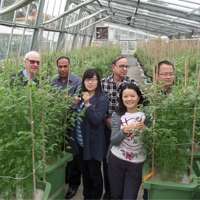World's largest drought resistance experiment on chickpeas under way at UWA

Researchers from The University of Western Australia's Institute of Agriculture are conducting the world's largest chickpea experiment on drought resistance.
Led by Hackett Professor Kadambot Siddique, the project aims to understand how chickpea adapts to terminal drought, which is experienced in most seasons in southern Australia. Drought is an important limiting factor in achieving higher, stable yields and thus greater profitability.
Based on results from previous research in the field with a wide range of germplasm, 10 lines of chickpea with similar flowering times were selected for preliminary studies. These lines were used to investigate physiological and biochemical mechanisms for adaptation to terminal drought in the UWA glasshouse.
Plants were grown in 80L wheelie bins, each containing 105kg of field soil from a site in Cunderdin, Western Australia. Growing chickpea in the large bins simulated conditions in the field more closely and also enabled soil moisture to last longer once watering is withheld.
A specially designed balance with a maximum capacity of 200kg and an accuracy of 10g had to be built for the experiment.
"This allows us to control water accurately and monitor soil water content closely after water stress," Professor Siddique said. "We are the first group in Australia to use this system which mimics the field situation."
Chickpea is globally one of the most important grain legumes and is now the largest grain legume crop in Australia. There is huge demand for the protein-rich crop in India, a nation that has the world's largest population of vegetarians.
"Australia is amongst the significant exporters of chickpea to India, but the amount we produce is limited by drought that is endemic in most of the dryland areas of Australia," Professor Siddique said. "This research will help us to understand the physiology, biochemistry and genetics behind drought resistance in chickpea, and develop screening tools for breeders to select varieties that are best suited for regions where water is limited."
The ten chickpea lines will be studied for detailed physiological and biochemical mechanisms associated with drought resistance, including leaf water potential, gas exchange characteristics, seed filling rate, the role of abscisic acid (a hormone closely related to drought stress) and key enzymes in seed development. Preliminary gene expression studies related to drought resistance will be done in collaboration with colleagues from the University of Melbourne and RMIT University.
Provided by University of Western Australia



















